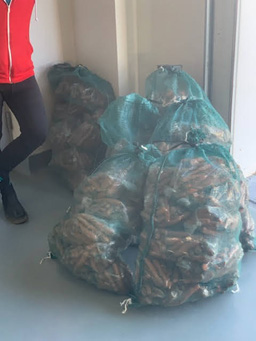Food for thought: it’s estimated that half of Canada’s food supply goes to waste, roughly a $50 billion loss. To make matters even worse, 1 in every 7 Canadian households suffers from some form of food insecurity. Even our environment is affected: when food decomposes in landfills, it releases harmful greenhouse gases, accounting for an estimated 8% of global emissions.
There is a need to make our food system more equitable and efficient from the farm gate to the dinner plate. Leanne Wilson knows this, and she’s turning that food for thought into action.
A growing problem with food waste

A self-described “Prairie girl,” Leanne spent most of her career in agriculture, including a four-year stint halfway across the world working with Horticulture Australia. Four years ago she arrived at Agriculture and Agri-Food Canada (AAFC), taking on the role of Associate Director at St. John’s Research and Development Centre.
Upon her arrival, she was handed a security pass, given a desk with a nice view, and immediately asked whether or not it would be possible to donate surplus crops.
This enormous question has plagued scientists, laboratory technicians, and other researchers for years. Most perishable horticultural crops harvested at AAFC research centres have always been composted and worked back into the soil to help replenish nutrients. But there was more than enough extra fruits and vegetables to create rich soil for the research program while also providing healthy meals for families in need. COVID-19 added urgency to the project because the need for food donations was at its highest level in decades.
Leanne took the task to heart. With all the challenges the world faced during the global pandemic, she wanted to contribute positively in some small way. “It’s important for us to show that we are trying, in our own way, to reduce food waste,” says Leanne.
So Leanne and her team at St. John’s got down to work on what would quickly become a labour of love.
Taking action on food waste
When the Government of Canada was holding public consultations for the country’s first-ever Food Policy for Canada in 2017, Canadians made it clear they want to be part of the solution to the food waste problem. They pushed for it to be included as one of the first four action areas for the new Policy. To help build even more momentum for change, AAFC launched the Food Waste Reduction Challenge, which is incubating the best ideas to make the biggest impact.
Leaving the comfort zone
As with many good ideas, the hardest part was the execution.
Leanne was relatively new to government, and felt that she was able to bring new ideas forward and push the department outside of its comfort zone a bit: “There were lots of people who supported the idea. It just takes a bit of legwork sometimes to get something moving.”
The first step was ensuring that the plan met the Government of Canada’s high standard for values and ethics. Selling this perishable produce was not a feasible option, so the Department had to follow the rules on giving away items of value. Leanne and her team set up a pilot project which would grant AAFC research stations the authority to donate their surplus crops.
With a plan in place, they just had one problem: finding a way to get all the fresh produce into people’s hands. As much as they wanted to, dropping off baskets of food to individual houses wasn’t a real option. They needed help from a trusted source who could distribute the food in an equitable way.
Building momentum for change

To help make that happen, Leanne teamed up with the GCSurplus team at Public Services and Procurement Canada. GCSurplus sells surplus government goods, such as furniture and vehicles, to the general public through an online auction site and also donates surplus goods to eligible organizations. It was the perfect collaboration between the departments, and the GCSurplus team set up a pilot project with Food Banks Canada, a trusted organization that could distribute the food quickly.
As Josée Doucet, Senior Director of GCSurplus, says: “What a great way to give back as a united public service and provide overall value to Canada.”
What was the end result of all this innovation and teamwork?
St. John’s Food Banks Canada received 550 pounds of carrots and over 10,000 pounds of potatoes. On the west coast, AAFC’s Summerland Research and Development Centre in British Columbia donated 1,000 pounds of apples to food banks. And this is just the beginning. As the initiative ramps up, Leanne expects more donations in the coming year from research centres across the country.
“The healthy produce donated through the program allowed some fortunate food banks to add to their fresh offerings,” says Kirstin Beardsley, CEO of Food Banks Canada. “Food banks constantly aim to offer fresher food because fruits and vegetables help build a solid foundation of health and are highly desired by clients and their families.” The right to access enough healthy and fresh food is an important part of the organization’s “vision of a Canada where no one goes hungry,” she adds.
With the success of the pilot project, Leanne is hoping it can be a model for others. When it comes to reducing food waste, increasing food security, and protecting the environment, individual efforts like this can multiply quickly. “We all have to do our part, and we have the ability to do our part,” says Leanne. “At the end of the day, it’s a simple process.”
Get more Agri-info
- Want more stories like this? Explore what else Agri-info has to offer.
- Interested in reporting on this story? Contact AAFC Media Relations at aafc.mediarelations-relationsmedias.aac@agr.gc.ca to arrange an interview with one of our experts.